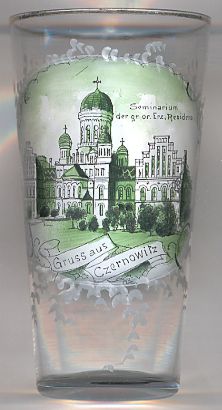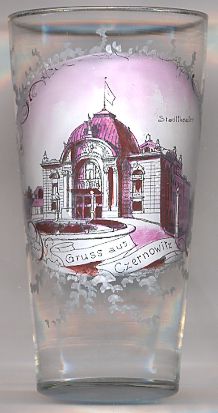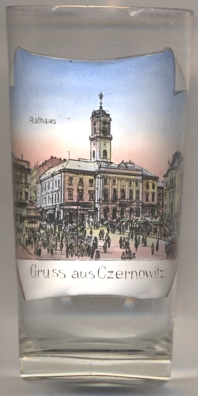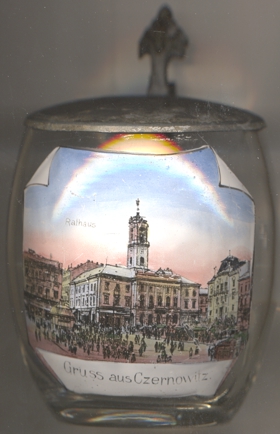

|
| УКРАЇНА UKRAJINA | UKRAINE |
| Чернівецька область Černivec'ka oblast' | Černivci province |
| Чернівецька міська рада Černivec'ka mis'ka rada | Černivci city municipality |
Чернівці (Černivci) is situated at an elevation of 248 m on the river Prut in the norther Bukovina region of western Ukraine. The city is the administrative centre of the Černivci oblast (province), its population is about 242,300 (2005). Černivci is also the administrative centre of the Černivci raion (district) and is also designated as its own district (city municipality) within that district.
Archeological evidence discovered in the area surrounding Černivci indicates that a local population existed in that area since the neolithic era. Remains of the early Slavic tribes in the area date back to the 2nd–5th centuries. A fortified settlement located on the left shore of the Prut river dates back to the time of the Principality of Halych and is thought to have been built by Grand Prince Yaroslav Osmomysl, who ruled from 1153–1187. Legendary accounts refer to this fortress-city as Čern, or Black city, and it is said to owe its name to the black color of the city walls, built from dark oak layered with local black-colored soil. This stronghold was unfortunately destroyed during the Mongol invasion in 1259. However, the remaining ramparts of the fortress were still used for defense purposes; they were augmented with several bastions, one of which is still extant, in the 17th century. Beginning in 1359, for more than 400 years, the city and its surroundings became part of the Principality of Moldavia. Czernowitz became a part of the Duchy of Bukovina, a crownland of the Austrian Empire, in 1775 and received the Magdeburg rights soon thereafter. During the 19th and early 20th century, Černivci became a center of the Romanian, and also Ukrainian nationalist movement. Černivci was also the site of the first Yiddish language conference in 1908. The university of Černivci was founded in 1875, marking the centennium of its being part of the Austrian empire. When Austria-Hungary dissolved in 1918, Černivci (in Romanian Cernăuţi) and the surrounding region became part of the Kingdom of Romania following the Treaty of Paris / Saint-Germain-en-Laye (1919). In 1940, the Red Army occupied the region and Černivci (in Russian Черновцы / Černovcy or Черновицы / Černovicy) subsequently became a part of the Ukrainian SSR of the Soviet Union. In 1941 it was recaptured by Romania before it was returned to the Ukrainian SSR in 1944. Since 1991 Černivci is part of independent Ukraine.
Many famous people were born in Černivci. Among those many are: the poets Rose Ausländer and Paul Celan, the biochemist Erwin Chargaff, the architect and painter Oskar Laske, the writers Josef Burg and Gregor von Rezzori, and the drama expert and librettist Joseph Gregor, to name just a few...

The  Seminarium of the Greek-Orthodox Archiepiscopal Residence [near left, no. 2446]
is the impressive residence of the Greek-Orthodox Metropolitans of Bukovina and Dalmatia.
It was built in 1864–1882 by the Czech architect Josef Hlavka and still is the most important landmark of Černivci.
Since the Soviet period, the former residence is used by the university of Černivci which had been founded in 1875 by
Emperor Franz Joseph I of Austria. The complex was listed as a UNESCO World Heritage site in 2011.
(See also list of other UNESCO World Heritage sites depicted on glasses of this collection)
Seminarium of the Greek-Orthodox Archiepiscopal Residence [near left, no. 2446]
is the impressive residence of the Greek-Orthodox Metropolitans of Bukovina and Dalmatia.
It was built in 1864–1882 by the Czech architect Josef Hlavka and still is the most important landmark of Černivci.
Since the Soviet period, the former residence is used by the university of Černivci which had been founded in 1875 by
Emperor Franz Joseph I of Austria. The complex was listed as a UNESCO World Heritage site in 2011.
(See also list of other UNESCO World Heritage sites depicted on glasses of this collection)

The  Theatre (Teatrul im. Olgi Kobylyanskoy) [left, no. 2445] was built in 1904–1905 as Municipal Theatre
by the famous architects Ferdinand Fellner and Hermann Helmer from Vienna.
The design had been projected for Czernowitz in 1900, but the project was put on hold for several years. Subsequently, the plans were first used by
Fellner and Helmer for the Stadttheater Fürth (Germany) in 1901–1902. As the Czernowitz project was taken up again, the original plans were used
with slight alterations. Hence, the theatres of Černivci and Fürth are very similar in appearance. The theatre's capacity was 813 seats.
When Czernowitz became the Romanian city of Cernăuţi, the theatre was renamed Teatrul National on 2nd January 1922.
When Černivci became Ukrainian, the theatre was renamed in honour of the Ukrainian poet
Olga Kobylyanska whose statue is located in front of the theatre.
Theatre (Teatrul im. Olgi Kobylyanskoy) [left, no. 2445] was built in 1904–1905 as Municipal Theatre
by the famous architects Ferdinand Fellner and Hermann Helmer from Vienna.
The design had been projected for Czernowitz in 1900, but the project was put on hold for several years. Subsequently, the plans were first used by
Fellner and Helmer for the Stadttheater Fürth (Germany) in 1901–1902. As the Czernowitz project was taken up again, the original plans were used
with slight alterations. Hence, the theatres of Černivci and Fürth are very similar in appearance. The theatre's capacity was 813 seats.
When Czernowitz became the Romanian city of Cernăuţi, the theatre was renamed Teatrul National on 2nd January 1922.
When Černivci became Ukrainian, the theatre was renamed in honour of the Ukrainian poet
Olga Kobylyanska whose statue is located in front of the theatre.
(See also list of further buildings by Fellner and Helmer that are depicted on glasses of this collection.)


The  Town Hall [near left, no. 4434, and right, no. 4435]
is located in the central square of Černivci, Центральна площа
(Central'na plošča). The edifice was built in 1842–1848 after a design from the architect Andreas Mikulicz. The two-storey
tower with its height of 50 metres has become a popular landmark of the city.
Town Hall [near left, no. 4434, and right, no. 4435]
is located in the central square of Černivci, Центральна площа
(Central'na plošča). The edifice was built in 1842–1848 after a design from the architect Andreas Mikulicz. The two-storey
tower with its height of 50 metres has become a popular landmark of the city.
[http://en.wikipedia.org/wiki/Chernivtsi;
https://en.wikipedia.org/wiki/Residence_of_Bukovinian_and_Dalmatian_Metropolitans;
http://www.andreas-praefcke.de/carthalia/europe/ua_chernivtsi_teatr.htm;
https://www.bukowina-portal.de/de/ct/249]
![[scale]](lineal.jpg)